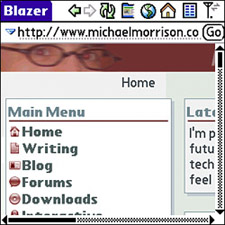The Blazer Web Browser and the Wireless Web
| Before getting into the specifics of the Blazer Web browser application, it's important to cover a few important concepts related to mobile browsing. First off, you've probably heard the expression "wireless Web." If so, you were quite likely hearing someone talk about WAP, even if he or she didn't realize it. WAP (pronounced so that it rhymes with "map") is a technology that enables wireless devices to receive data from the Internet and display it on their constrained displays. You can think of WAP as essentially a technology that supports a minimal Web browser on wireless devices. However, as its name clearly states, WAP is not an application but a protocol. WAP must be supported on both the client (device) and the Web server, and there must also be a WAP Gateway, which is an intermediary between the Internet and the device's mobile network. The WAP Gateway is responsible for converting WAP requests into traditional Web requests and vice versa. Web pages for WAP are somewhat different from traditional web pages in that they are written in a special markup language called Wireless Markup Language (WML) instead of the familiar HTML. WML also supports WMLScript, a scripting language that is a simplified version of JavaScript. Web pages designed for WAP tend to be minimal in design as well as content. The number of WAP/WML sites is limited, at least in comparison to normal HTTP/HTML sites. Note WAP is an important part of Treo Web browsing because many mobile websites are designed to be viewed by WAP Web browsers. The Web browser in your Treo device actually supports both WAP and HTTP. The Blazer Web browser application is designed to maximize the content area where web pages are actually displayed, which is important for WAP and critical for HTTP. Along the top of the browser screen is a small title area that includes navigational components and information about the current browser session. More specifically, the following information is included in the Blazer browser's title area:
All this information is conveyed via text and small icons in the title area, as you can see in Figure 10.1. Figure 10.1. The title area in the Blazer Web browser includes a toolbar, a network signal strength icon, the current web page URL, and a Go button.
The Blazer toolbar provides access to common browser commands and features. Following are the toolbar buttons as they appear from left to right along the top of the Blazer screen:
These commands are standard ones found in just about any Web browser. The Blazer Web browser functions just like a desktop Web browser in terms of maintaining a history of visited websites and keeping track of opened pages as a sequence that can be moved through forward or backward. In addition to offering a glimpse of the currently viewed web page, the address bar near the top of the Blazer screen enables you to enter a URL directly and navigate to a specific page by address. Just tap the address bar, enter the URL, and then tap the Go button to the right of the address. |
